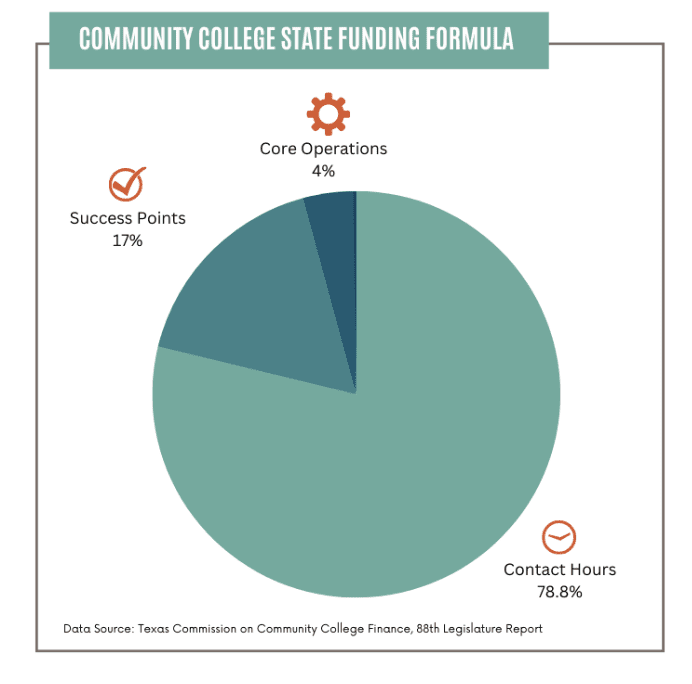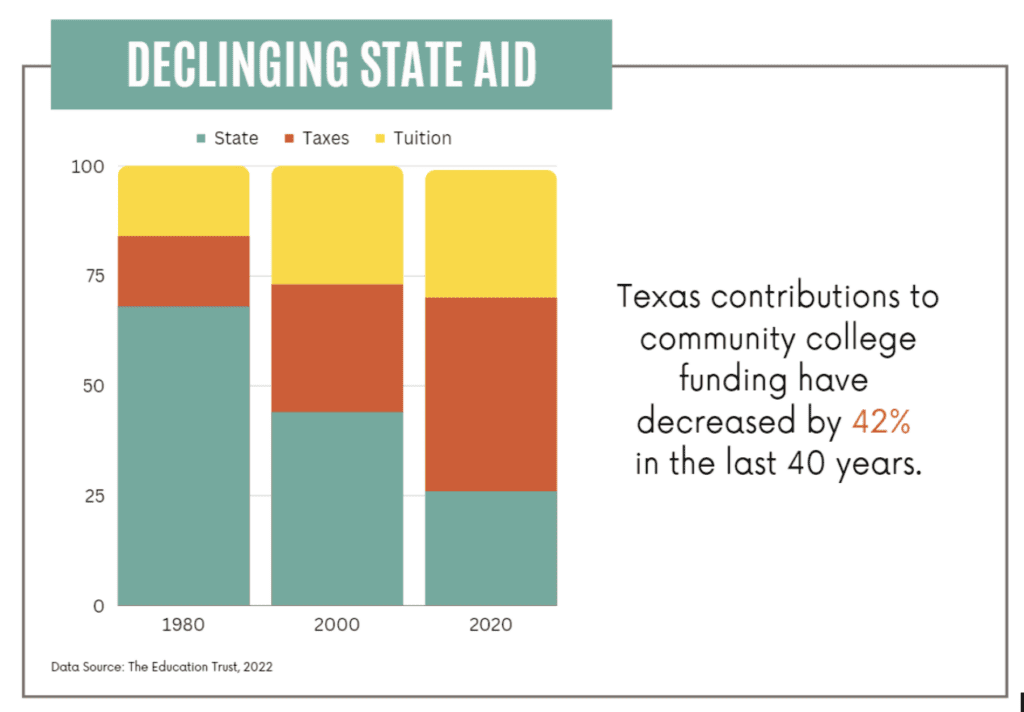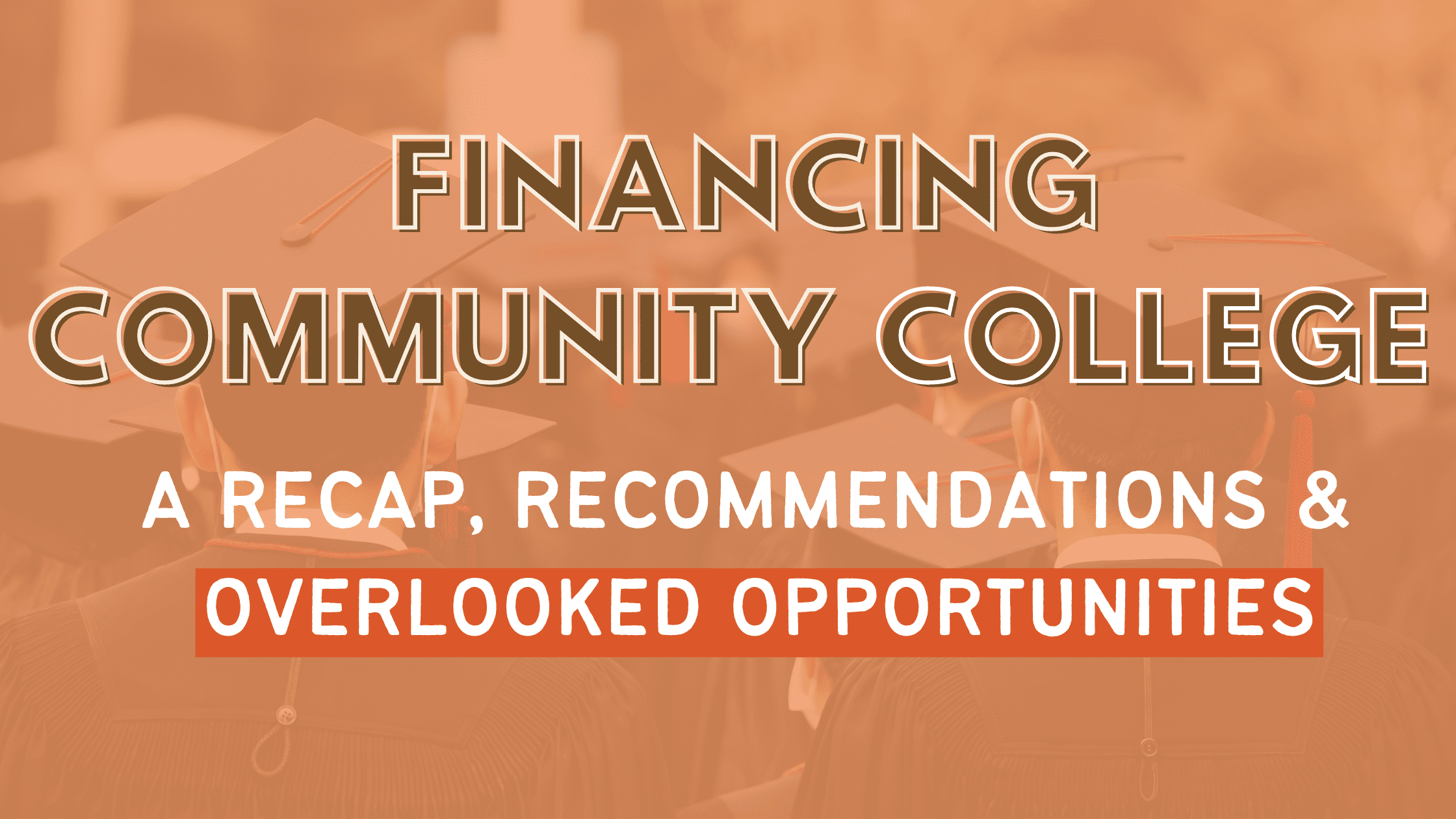In January, hundreds of community college students were rallying for a more equitable education on the steps of the Texas Capitol. Our state’s 50 community college districts provide their surrounding communities with opportunities that shift the economic and social well-being of their students. Collectively, our community colleges help Texans thrive by training and educating students to work in the trade or career of their choice.
Although community colleges provide 92% of workforce credentials for jobs in Texas, these colleges face financial difficulties due to an inequitable funding system and declining enrollments as a result of the pandemic. However, community colleges must ensure that the Texas workforce has the well-educated, trained, and skilled workers we need to maintain our growing society. Community colleges also allow all Texans to increase their social well-being and experience social mobility, regardless of their race or socioeconomic background.
Fewer high school students are enrolling directly into higher education programs — even among students in the top 10% of their class (Higher Education House Committee Report) — which could potentially lead to more enrolling in community college later on.
Inequities in Our Current Funding Model
Community colleges are funded with general revenue through four components:
- formula funding;
- non-formula support funding;
- need-based supplements; and
- health and retirement benefits.
Most community college funding comes from the funding formula, which accounts for 74% of the appropriations. The funding formula consists of three parts:
- contact hours;
- success points; and
- core operations.

Most of the funding formula is based on contact hours (79%) and success points (17%). The number of contact hours is determined by the number of hours of academic or technical instruction for which students are scheduled. Success points, on the other hand, are a form of outcome-based funding originally established a decade ago that is given to colleges based on their performance. The student success point model is divided into five areas:
- College Readiness: points for student completion of developmental math, reading, or writing courses.
- First College-Level Course: points for when students pass their first college-level math, reading, or writing course.
- Progress to Credential: points for student completion of a semester (15 credit hours) and/or a full year (30 credit hours).
- Credentials Awarded: points for awarding degrees or certificates.
- Transfer: points when students transfer to a university after completing 15 credit hours.
Unfortunately, contact hours at a college can remain low even when enrollment costs increase. Equity, cost, and student need issues weaken this model’s accuracy and effectiveness. Community colleges receive fewer success points for serving first-generation students, economically or academically disadvantaged students, English language learners, or students over the age of 24, many of whom may require additional resources in order to meet the goals outlined in the success point model. As a result of serving these students and losing success points, community colleges are forced to spend less money for each of those students, worsening existing inequities.
From a cost analysis perspective, the amount that community colleges are spending on low-income students, adult leaders, English language learners, and students who need additional academic resources is not enough to provide equal opportunity, let alone an equitable education, for the students who can benefit the most.
State contributions have accounted for $2.5 billion of community college funding during the 2022-2023 academic year, which is only 19% of funding overall. The state is poised to contribute more money to community colleges this legislative session. As filed, the Senate and House budgets allot an additional $650 million to fund the recommendations of the Texas Commission on Community College Finance, bringing the state contribution amount to $3.15 billion.

Since 1980, Texas has reduced the amount of funding it provides directly to community colleges, forcing local property taxes to make up the difference. According to The Education Trust, over half of community college funding is generated by property taxes (39%) and student tuition and fees (14%). Additional funding comes from federal funding (20%) and institutional resources (7%), which, when combined, still contribute a larger percentage of funding to community colleges than the state (26%). Because institutions depend on funding from local property taxes (similar to K-12 education), the amount of money an institution can access varies based on geographic location and the surrounding community’s capacity, not its effort.
Local property taxes are optional for taxing districts — the local community of a given institution must vote to approve allocating funding from tax dollars. Only two-thirds of the state’s property value contributes to community colleges, and vast funding disparities mean that colleges raise anywhere between $11 and $1,100 per full-time equivalent student per penny of tax effort — solely based on location.
Lack of adequate support to support students with financial needs
Need-based financial aid is not uncommon. Many states and institutions provide some type of need-based assistance to help students who fall at or below a certain financial level. But Texas does not provide enough funding for institutions to support all students who demonstrate a financial need. Community college students with a financial need in Texas have extremely limited access to grant aid when enrolling into a public two-year college (community colleges, technical institutes, or two-year public state colleges) through Texas Educational Opportunity Grants (TEOG).
This 2022-2023 school year, full-time community college students can receive up to $1,707 per semester, which is less than the previous academic school year. While the Texas Higher Education Coordinating Board is providing over $600 million each year of state aid for 100,000 students with financial need, it’s simply not enough. Texas cannot expect to recruit and retain an educated workforce to meet the increasing demand of our growing economy without meeting the financial needs of more, if not all, students.
Fewer than 3 out of 10 students at community colleges are receiving grant aid from the TEOG. On the other hand, the TEOG provides nearly 7 out of 10 students with financial aid at four-year colleges and universities. Let’s be clear: this is not an either/or conversation where the state must decide between funding community colleges or four-year colleges. Instead, community colleges need access to more aid than they currently receive, but all two- and four-year public institutions within the state of Texas should have access to enough aid that they can meet 100% of the financial needs of their students.
A Review of the Community College Finance Commission’s Recommendations and Missed Opportunities
View an in-depth breakdown of the commission’s recommendations here.
Many of the commission’s recommendations are vital to designing funding formulas that will help community colleges in their efforts to educate and train a wide variety of students and adult learners. From the above recommendations, a bill must include critical components that 1) account for educating and training students who are economically and academically disadvantaged, and 2) support a wide variety of education and training programs.
The recommendations to increase resources for community colleges seek innovative solutions to enrollment and capacity issues. Policymakers will need to ensure that any potential grants for high-demand fields of study are targeted to rural colleges and colleges that have smaller levels of enrollment in the desired areas. The design and criteria for the seed grants must also be accessible for colleges that may not have the time or capacity to spend hours completing forms and applications. These seed grants will also need to be large enough to truly increase the enrollment and capacity of high-demand fields of study in rural and smaller colleges.
Additionally, in order for the shared services recommendations to succeed, all Texans need access to high-speed internet, regardless of where they live — especially as colleges continue to rely on online courses.
This is a pivotal moment for community and two-year colleges in Texas. Policymakers and advocates should prioritize affordability and accessibility throughout the 88th Legislature. Across college, student, and program types, any proposed solution must be mindful of the following:
- Additional attention is needed for two-year colleges, in addition to traditional community colleges, to ensure that all Texans have access to higher education.
- We also cannot overlook that community and two-year colleges serve a wide variety of students from various backgrounds. They serve high school students, young adults, and adult learners that are increasingly Black and Hispanic/Latino, all of whom deserve the resources and support they need to reach their academic and career goals. Minority* Serving Institutions (MSIs) are extremely vulnerable to funding formulas that depend on revenue from local property taxes due to systemic redlining and housing inequities. Not only do colleges need direct funding, but students also need access to financial aid that does not depend on student loans, programs that place money directly into their hands, and additional support for their social and emotional well-being (ex. therapy) or family care (ex. stipends for daycare centers).
- Finally, we must not penalize colleges for offering traditional humanities, social sciences, or arts degrees, otherwise we risk producing a system that discourages students from enrolling in non-”high demand” programs. Additional funding for these colleges cannot be solely tied to what policymakers or businesses deem as “high demand.”
* The word “minority” can be harmful and exclusionary when used to refer to groups of people who are marginalized or oppressed. It can create a power dynamic that reinforces the idea that these groups are inferior or less important than the dominant group. Additionally, the term “minority” is often based on numerical representation rather than social or political power, which can undermine the experiences of individuals within these groups who may face discrimination and disadvantage. Every Texan prioritizes language that is inclusive and recognizes the diversity, breadth, and complexity of people’s experiences and identities.
